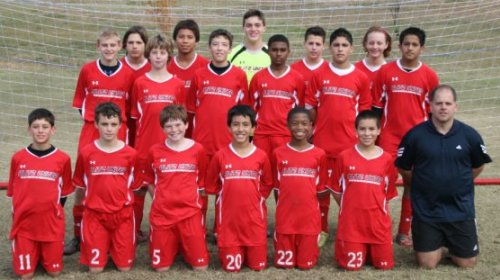
The best and fastest way to learn a sport is to watch and imitate a champion.
Jean-Claude Kelly
Sprains and strains are among the most common injuries in all sports, including soccer.
Here are some facts about sprains and strains from the American Academy of Orthopaedic Surgeons.
A sprain is a stretch and/or tear of a ligament, the fibrous band of connective tissue that joins the end of one bone with another. Ligaments stabilize and support the body's joints. For example, ligaments in the knee connect the upper leg with the lower leg, enabling people to walk and run.
A strain is a twist, pull and/or tear of a muscle and/or tendon. Tendons are fibrous cords of tissue that attach muscles to bone.
A sprain is caused by direct or indirect trauma (a fall, a blow to the body, etc.) that knocks a joint out of position, and overstretches, and, in severe cases, ruptures the supporting ligaments. Typically, this injury occurs when an individual lands on an outstretched arm; slides into a base; jumps up and lands on the side of the foot; or runs on an uneven surface.
Chronic strains are the result of overuse - prolonged, repetitive movement - of muscles and tendons. Inadequate rest breaks during intensive training precipitates a strain. Acute strains are caused by a direct blow to the body, overstretching, or excessive muscle contraction.
Professional and amateur athletes and the general public, as well, can sustain this injury. People at risk for the injury have a history of sprains and strains, are overweight, and are in poor physical condition.
All sports and exercises, even walking, carry a risk of sprains. The anatomic areas most at risk for a sprain depend on the specific activities involved. For example, basketball, volleyball, soccer, and other jumping sports share a risk for foot, leg, and ankle sprains. Soccer, football, hockey, boxing, wrestling, and other contact sports put athletes at risk for strains. So do sports that feature quick starts (hurdling, long jump, running races, etc.). Gymnastics, tennis, rowing, golf-sports that require extensive gripping-have a high incidence of hand strains. Elbow strains frequently occur in racquet, throwing, and contact sports.
While the intensity varies, pain, bruising, and inflammation are common to all three categories of sprains-mild, moderate, severe. The individual will usually feel a tear or pop in the joint. A severe sprain produces excruciating pain at the moment of injury, as ligaments tear completely, or separate from the bone. This loosening makes the joint nonfunctional. A moderate sprain partially tears the ligament, producing joint instability, and some swelling. A ligament is stretched in a mild sprain, but there is no joint loosening.
Typical indications include pain, muscle spasm, muscle weakness, swelling, inflammation, and cramping. In severe strains, the muscle and/or tendon is partially or completely ruptured, often incapacitating the individual. Some muscle function will be lost with a moderate strain, where the muscle/tendon is overstretched and slightly torn. With a mild strain, the muscle/tendon is stretched or pulled, slightly. Some common strains are:
Rest, ice, compression and elevation (RICE) usually will help minimize the damage. It is important in all but mild cases for a medical doctor to evaluate the injury and establish a treatment and rehabilitation plan. A severe sprain or strain may require surgery or immobilization followed by months of therapy. Mild sprains and strains may require rehabilitation exercises and activity modification during recovery.
No one is immune to sprains and strains, but here are some tips developed by the American Academy of Orthopaedic Surgeons to help reduce your injury risk: